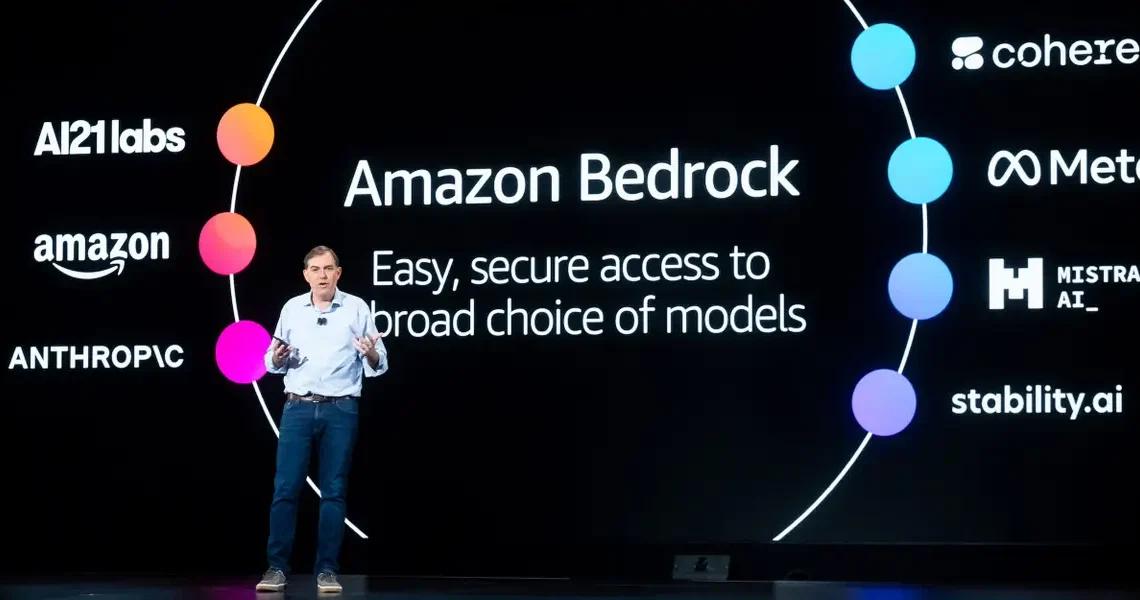This summer, Amazon’s cloud business struggled to keep pace with surging AI demand and missed out on real revenue for its flagship AI product.
Amazon Web Services’s Bedrock service sits at the center of the company’s AI push. It lets developers tap into powerful models, including Anthropic’s Claude and Meta’s Llama.
But over the summer, Bedrock hit “critical capacity constraints” that drove some customers to rival services, such as Google‘s cloud service, according to an internal July document obtained by Business Insider.
The shortages led to tens of millions of dollars in lost or delayed revenue. Epic Games shifted a $10 million Fortnite project to Google Cloud after AWS failed to provide enough quota for Bedrock, according to the document. (Quota limits control how much intelligence customers can access via AI cloud services).
Oil trader Vitol weighed moving some projects away from AWS, a decision that risked a $3.5 million revenue hit amid “prolonged quota approvals,” the document also warned. Other customers, including Atlassian and GovTech Singapore, were waiting on quota increases this summer, delaying at least $52.6 million in projected sales, the document also disclosed.
Bedrock was “experiencing critical capacity constraints that are threatening customer adoption and potentially causing substantial revenue loss across multiple industries,” the July document stated.
The fallout underscores the financial toll of AWS’s capacity crunch, and it explains why the biggest cloud companies are rushing to build as many AI data centers as possible right now. High demand is a good thing, but if you can’t satisfy this and customers go to rivals, that’s a frustrating problem.
Indeed, Amazon CEO Andy Jassy has repeatedly stressed the need to ramp up cloud infrastructure, particularly AI chips and data center power. It’s unclear whether the company has fully resolved these issues. Three current and former employees said the capacity crunch remained one of AWS’s top concerns through September.
An Amazon spokesperson said Bedrock is “experiencing rapid growth” and AWS is adding capacity to meet that demand. Reviewing customer feedback is a core part of Amazon’s culture, which helps the company improve its products and services, the spokesperson added.
“At Amazon, we’re vocally self-critical because that’s how we drive continuous improvement and deliver better results for customers,” the spokesperson said in a statement. “This internal candor is a feature of our culture, not a flaw. We’re grateful for all customer feedback—including challenges they encounter—because it helps us make Bedrock even better, and that’s exactly how you build a scalable, sustainable business that serves customers well over the long term.”
A Google spokesperson declined to comment. Representatives for Anthropic and Epic Games didn’t respond to requests for comment.
‘Accelerating capacity’
Expanding data center capacity, as with other cloud providers, is one of AWS’s top priorities.
During an October earnings call, Jassy said AWS had been “focused on accelerating capacity the last several months,” adding more than 3.8 gigawatts of power over the past year, more than any other cloud provider. AWS has doubled its power capacity since 2022 and plans to double it again by 2027, he noted.
Jassy added that Amazon will remain “very aggressive” in scaling up capacity to meet booming demand, noting that AWS can monetize new infrastructure almost immediately. Bedrock, he said, is already showing potential to grow as large as EC2, one of AWS’s most successful cloud products and a key profit engine.
Part of Bedrock’s shortages may stem from prioritizing large clients. In October, Jassy said most of Bedrock’s workloads run on AWS’s in-house AI chip, Trainium, but that usage so far has come mainly from “a small number of very large customers.” He added that more mid-sized companies are expected to adopt the next-generation Trainium in the coming months.
Amazon is expected to reveal more details about Bedrock and its broader cloud strategy during its annual re:Invent conference in early December.
‘Urgent need’
The July AWS document said the capacity crunch was hitting customers across industries, including finance, gaming, and tech. Companies such as HelloFresh, Zalando, and Ryanair were among those affected.
At the same time, “slow capacity approval and denial of spiky workload requests” prevented firms like Stripe, Robinhood, and Vanguard from moving AI workloads from Anthropic to Bedrock, the document noted.
“These constraints are forcing customers to explore alternative providers like GCP, OpenAI, and Anthropic, signaling an urgent need for AWS to address its Bedrock service quota and performance challenges to maintain competitive positioning in the rapidly evolving GenAI market,” the document stated.
Quota limits in Bedrock are based on how many AI tokens you can process in a minute, or the number of API calls you can make in a given time period. (Tokens are how AI models break queries down into digestible data chunks. Industry pricing is based on how many tokens are processed. APIs are application programming interfaces, a common way applications share data).
In recent weeks, investors have grown uneasy over the tech industry’s massive AI spending, with fears of a potential bubble weighing on markets.
Amazon’s AI capacity issues are a double-edge sword here. On one hand, these challenges suggest customer demand is still very strong. On the other, it’s another reason for big tech companies to keep spending heavily, potentially fueling the AI bubble even more.
Amazon has said it plans to pour $125 billion into capital expenditures this year, and even more in 2026. AWS revenue climbed to $33 billion last quarter, up 20% year over year, marking its fastest growth since 2022.
Performance issues
It wasn’t just capacity woes driving customer workloads away from Bedrock. Latency and missing features also played a major role.
Customers using Anthropic’s Claude models through Bedrock opted to switch to Anthropic’s own platform or Google Cloud because of “ongoing capacity, latency, and feature parity issues,” according to the July AWS document. Companies such as Figma, Intercom, and Wealthsimple were among those migrating their workloads “due to one or several of these challenges.”
The UK’s Government Digital Service considered a move to Microsoft’s cloud because Anthropic’s Claude 3.7 Sonnet model ran slower on Bedrock, the document added.
Thomson Reuters also chose Google Cloud over Bedrock for its CoCounsel AI product after finding AWS’s service was 15% to 30% slower and lacked key government compliance certifications, the document showed. In May, executives raised these concerns with AWS leadership, including CEO Matt Garman and compute VP Dave Brown, leading both companies to agree to monthly review meetings.
Joel Hron, CTO of Thomson Reuters, told Business Insider that the company recently moved “one component of an AI workload to Google Cloud to prioritize latency.” He added that Thomson Reuters still runs substantial workloads on AWS and Anthropic as part of its multi-model, multi-cloud strategy.
‘Increasing competition’ from Google
The July AWS document also noted that Bedrock was losing ground to Google’s Gemini models, which boast five to six times larger quota limits and, in many cases, better performance.
When comparing accessing Claude via Bedrock against Gemini Pro, the internal report said the Google model outperformed “across multiple benchmarks.” The document also noted that Gemini Flash, a smaller, cheaper Google model, “delivers comparable quality at a fraction of the cost.” (And this was before Google’s Gemini 3 launch, which improved AI performance further for the internet giant).
Some startups jumped ship because of this. Financial startup TainAI shifted 40% of its Claude workloads from Bedrock to Gemini Flash, saving $85,000 a day, while Hotel Planner was planning to move to Google Cloud or OpenAI, the document noted.
The broader concern, according to the document, is that AWS lacked a cohesive product vision for AI inference, the main space in which Bedrock competes. Rivals such as Databricks, FireworksAI, and Nvidia’s Dynamo were quickly pulling ahead, it noted.
Without a clear strategy or compelling long-term vision, AWS risked missing out on one of the most lucrative opportunities in the AI market, it warned.
“We are still missing an inspiring long-term vision and a holistic strategy,” the document said.
Have a tip? Contact this reporter via email at [email protected] or Signal, Telegram, or WhatsApp at 650-942-3061. Use a personal email address, a nonwork WiFi network, and a nonwork device; here’s our guide to sharing information securely.
Read the original article on Business Insider
The post Amazon’s AI capacity crunch and performance issues pushed customers to rivals including Google appeared first on Business Insider.




